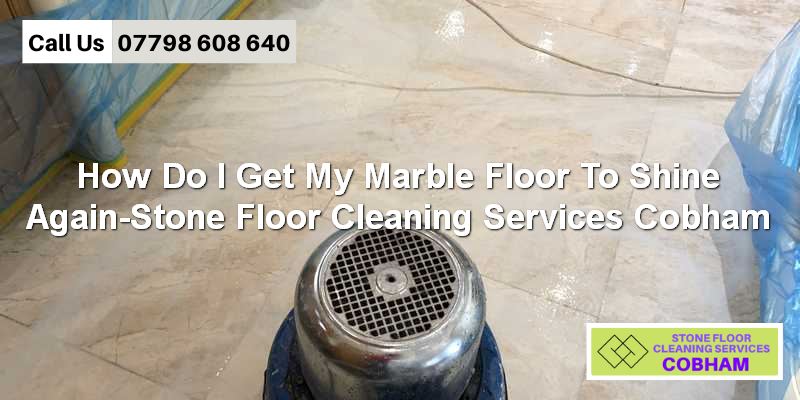How Do I Get My Marble Floor To Shine Again?

We receive many calls from customers concerned they may need to replace their dull marble floors. The most common complaint is that their marble floor has lost the lustrous factory polish. They have tried various cleaners and polished them but to no avail.
There is hope for your faded marble. Traffic wear, accidental spills, and scratches happen to all floors, including marble.
Eventually Marble Will Loose The Shine
When, rather than if, wear shows, don't give up. Don't just get rid of your old tiles. You can restore its former glory with the right stone restoration professionals in Surrey.
To properly polish marble and other calcium-based stone, it is essential to understand how stone gets its shine. This article will explain the polishing process and introduce some methods and the materials professionals use to get an industrial polish.
How Does Stone Become Shiny?
The beautiful shine we fall in love with is created by rubbing the stone using various abrasive materials. It's similar to sanding wood. They start with coarse abrasive diamond grit, followed by progressively finer particles until the stone is smooth. Each finer grit removes the scratches left by the previous coarser grit, resulting in finer scratches, continuing until they are so minor that the floor starts to show a reflection.
So, to create a deep shine on a stone, keep smoothing it until it shines.
Achieving a Polished Surface
Once a stone has a smooth reflective finish, there are three ways to give it a polished finish.
- Surface Powder Polishing
- Surfce Crystallisation
- Surface Coatings
Let's take a closer review of each one in the finer details.
Surface Powder Polishing
Once the marble has a reflective finish, powder polishing is most favoured by domestic and prestige commercial clients to give the mirror finish associated with polished marble.
Powder polishing utilises superfine abrasives to create the deep shine characteristic of newly polished marble surfaces.
Polishing powders contain oxalic acid to accelerate polishing. Oxalic acid can etch marble, leaving a dull, pitted finish, so only experienced professionals should do the work.
Surface Crystallisation
Crystallisation or vitrification involves spraying a mixture of acid, fluorosilicates and waxes on the marble floor and buffing it into the floor using steel wool pads. The steel wool heats the chemicals, making them react with the stone, creating a new shiny chemical film within the surface of the marble.
There is still a lot of debate in the marble industry about crystallisation. However, it gives a robust polished finish when completed by skilled craftsmen who understand the process.
Crystallisation has particular advantages for commercial flooring, where a high shine rather than a deep lustrous gloss is acceptable.
- It does not create a slurry, so it does not need a wet vacuum and the associated noise.
- The floor does not require sealing.
- The area can be back in use immediately after polishing.
- Small spaces can be repolished to match the surrounding floor
- They have the staff and equipment to maintain the finish regularly.
Topical Coatings
Coatings made from waxes, acrylics, or urethanes, create a sacrificial wear layer to protect the surface from wear and light damage.
Coatings are easy to apply and give a sheen or gloss appearance. However, they are softer than the stone, so the finish needs to be constantly topped up or burnished to retain the original finish. Also, coatings must be removed and reapplied regularly using strong alkaline chemicals and scrubbing equipment.
With marble, the main issue is usually the finish. Most homeowners and prestigious commercial buildings like hotels want the typical mirror finish, not a low-sheen or varnish gloss.
A shiny rather than mirror finish is more acceptable on heavy-use commercial floors where the finish can be maintained with buffing equipment and reapplied "out of hours".
As you can see, you can use these methods to restore the shine and polish to marble and other calcium-based stone surfaces: powder polishing, crystallisation, and coatings. Each has advantages and disadvantages, and the most suitable one depends on the homeowner's or business's needs and preferences.
If your marble floor has lost its lustrous factory polish, you don't have to replace it - you can restore its former glory by hiring the right stone restoration professionals.
Frequently Asked Questions About Marble Polishing
How do you polish old dull marble?
Old dull marble is polished using marble polishing powder, after the marble has been diamond ground or honed to to remove surface damage and scratches.
Which polish is best for marble?
Marble can be polished using marble polishing powder or by crystallization. Crystallization is popular for commercial floors, where speed and ease of use is paramount. Polishing powder created a finer finish, but it is time consuming and more messy compared to crystallization.
How do you make marble smooth and shiny?
Marble is made smooth by diamond grinding. Grinding removes uneven tile edges, leaving a smooth surface. Grinding leaved heavy scratches on the marble. Diamond honing removes the grinding scratches and prepares the marble for polishing. Finally the marble is polished to a lustrous gloss using marble polishing powder.